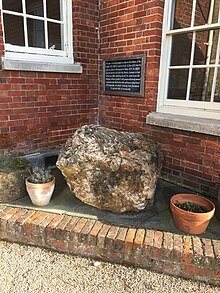HMS Pique (1834)
 HMS Pique sailing off of Portsmouth Harbour, 1838
| |
| History | |
|---|---|
| Name | HMS Pique |
| Builder | Devonport |
| Launched | 21 July 1834 |
| Fate | Broken up, 1910 |
| General characteristics | |
| Class and type | Fifth-rate frigate |
| Tons burthen | 1,633 tons |
| Length | 160 ft (49 m) |
| Beam | 49 ft (15 m) |
| Sail plan | Full-rigged ship |
| Armament | 36 × 32-pounder guns |
HMS Pique was a wooden
Service history
Pique was the first of a new class of medium-sized frigates designed by Sir William Symonds, Chief Surveyor of the Navy. Following commissioning she formed part of an experimental squadron, which were groups of ships sent out in the 1830s and 1840s to test new techniques of ship design, armament, building and propulsion.


In September 1835 she ran ashore in the Strait of Belle Isle. She was refloated and crossed the Atlantic rudderless and taking on water. In October the vessel arrived in Portsmouth for repairs where a large rock, which had plugged the hole in her hull, was removed. This stone remains on display in the Porter's Garden, Portsmouth Historic Dockyard.[1]
Under the command of Captain Edward Boxer (3 August 1837 – August 1841), Pique sailed to North America, the West Indies and the Mediterranean, including operations on the coast of Syria, as part of the squadron led by HMS Cambridge, and including Zebra and Vesuvius.

In 1840 Pique saw service in the bombardment of the city of Acre under the command of Admiral Robert Stopford. For the engagement, Pique was assigned to the far northern end of the line, north-northeast of the much larger HMS Waterloo and at a greater distance from the city than the rest of Stopford's fleet.[2] Despite this unfavourable position, accurate gunnery enabled Pique to score several hits on the town. In 2012 renovation works along Acre's city wall uncovered three cannonballs fired by Pique during the battle, the shots having struck within three metres (9.8 ft) of each other and embedded in the wall at depths of up to 65 centimetres (26 in).[2]
Between 1841 and 1846 Pique served on the
From 1872 she was a
Fate
Pique was sold for scrap on 12 July 1910, raising £2,300.[5]
References
- ^ "Portsmouth's Historic Dockyard – The Rock from HMS Pique". memorialsinportsmouth.co.uk. Retrieved 15 February 2020.
- ^ a b Kahanov et al, 2014, pp. 147-149
- ^ "Cable Timeline: 1845–1900". atlantic-cable.com. Retrieved 15 February 2020.
- ^ Moseley, Brian (15 January 2011). "Hospital Ships in Plymouth Sound". The Encyclopaedia of Plymouth History. Archived from the original on 19 December 2013. Retrieved 12 February 2015.
- ^ "Naval Matters – Past and Prospective: Portsmouth Dockyard". The Marine Engineer and Naval Architect. Vol. 33. August 1910. p. 10.
Bibliography
- ISBN 978-1-86176-281-8.
- Kahanov, Yaacov; Stern, Eliezer; Cvikel, Deborah & Me-Bar, Yoav (2014), "Between Shoal and Wall: The naval bombardment of Akko, 1840", The Mariner's Mirror, 100 (2): 147–167, S2CID 110466181
- Lavery, Brian (1983). The Ship of the Line - Volume 1: The development of the battlefleet 1650–1850. ISBN 0-85177-252-8.
